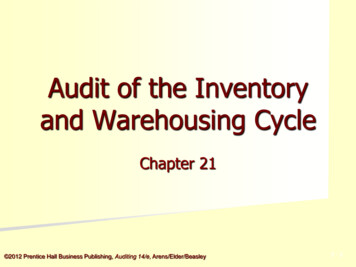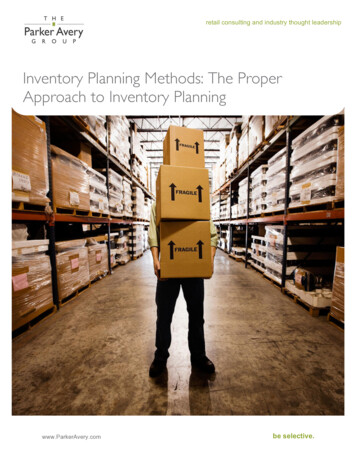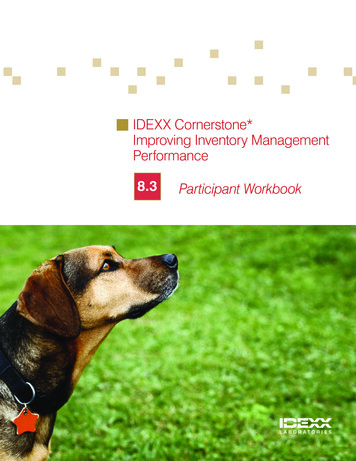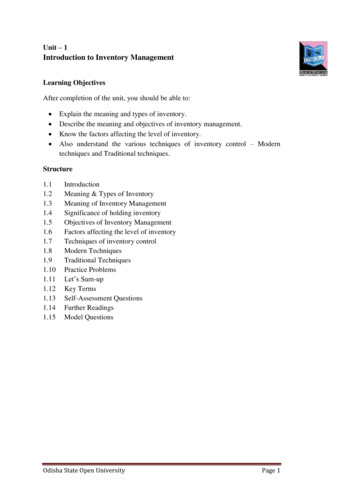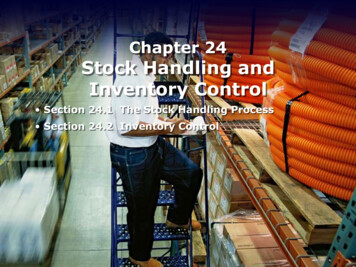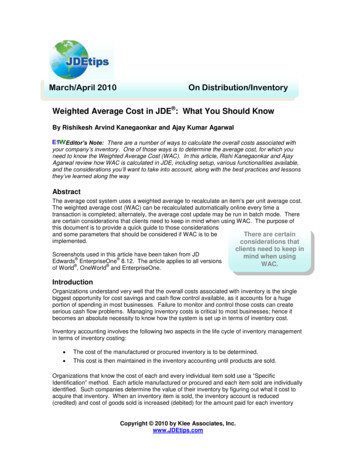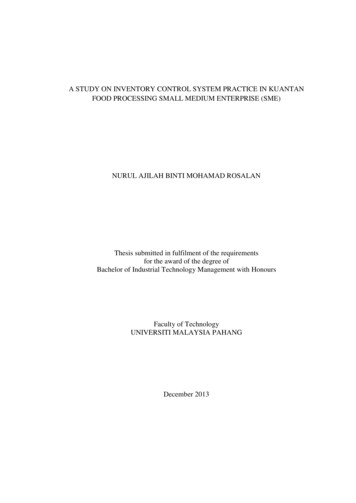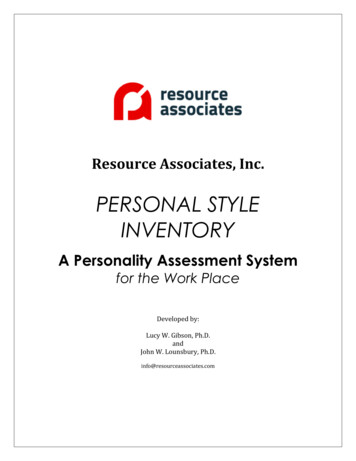
Transcription
Resource Associates, Inc.PERSONAL STYLEINVENTORYA Personality Assessment Systemfor the Work PlaceDeveloped by:Lucy W. Gibson, Ph.D.andJohn W. Lounsbury, Ph.D.info@resourceassociates.com
Table of ContentsIntroduction . 1Distinctive Features of the RA Personal Style Inventory. 3Wide Applicability for Business and Industry. 4Technical Foundation . 4Description of PSI Dimensions . 5Reliability of the RA Personal Style Inventory . 9Validity of RA Personal Style Inventory Dimensions .10Incremental Validity .20Adverse Impact .21Construct Validity .22Differences between Occupations on PSI Measures .29Relationship between PSI Measures and Job, Career, and Life Satisfaction .30Relationship Between PSI Personality Measures and Job / Career Satisfaction for Two SampleOccupations (HR Mgr and IT Professionals) .33Personality Predictors for Information Technology Workers .35Validity of Resource Associates Customer Service / Telesales Test .37Validity of Resource Associates Manufacturing / Maintenance Workers.38Validity of Resource Associates Store Manager Selection Test .38Validity of Resource Associates Restaurant Manager Selection Test .38Related References .39Resource Associates' Technical Reports and Published Research.40Appendix I: Glossary of Validity Terms .47Appendix II: Reliability and Validity Principles.48Table 1: Reliability Coefficients for the RA PSI Measures . 9Table 2: Bivariate Correlations of Overall Job Performance with Cognitive AptitudeBig Five Personality Traits and Work Drive by Validation Sample .17Table 3: Turnover Statistics .18Table 4: Relationship of Personality Variables and Turnover .19Table 5: Results of Hierarchical Multiple Regression for Cognitive Aptitude, Personalityand Work Drive Measures on Overall Job Performance .20Table 6: Results of Tests for Mean Difference on Work Drive .21Table 7: Personality Score Comparisons Between Younger vs. Older Employees.22Table 8: Differences in Males vs. Females on Personality Composite Predictor of Turnover .22Table 9: Correlations Between RA PSI and 16PF .24Table 10: Correlations Between Scales on the RA PSI and NEO-PIR .25Table 11: Correlations Between Scales on the RA PSI and Myers Briggs.25Table 12: Correlations Between RA PSI Cognitive Aptitude Scales and SelectedIntelligence and Aptitude Measures .25Table 13: Correlations Between RA PSI for Mgrs and 16PF for Mgr Jobs .26Table 14: Correlations Between Work Drive and other Personality, Satisfactionand Aptitude Measures .27Table 15: Occupations Grouped Into Homogenous Subsets on Work Drive .28Table 16: Correlations Between Job Satisfaction and Personality Traits by Occupational Group.29Table 17: Correlations Between Career Satisfaction and Personality Traits by Occupational Group .31Table 18: Results of Stepwise Multiple Regression Analyses for Predicting Career Satisfactionfor HR Mgrs .33Table 19: Correlations Between Personality Traits and Career Satisfaction for US and UK Samplesof HR Mgrs .34Table 20: Correlations Between Personality Traits and Job and Career Satisfaction for IT Workers .35Table 21: Results of Stepwise Multiple Regression for Job and Career Satisfaction for IT Workers .36Figure 1: Scores on "Unethical Behavior" Scale for Convicted Felons and Customer Svc Employees .14Figure 2: Test scores vs. Job Performance for Customer Service / Telesales .37
1Resource Associates, Inc.PERSONAL STYLE INVENTORYA Work-Based Personality Measurement SystemIn recent years, measurement of work-related personality characteristics has become an increasinglyimportant function of human resources and other organization units tasked with the responsibility foremployee selection. The domain of personnel assessment has expanded from an emphasis on job-relatedknowledge, skill, and abilities (KSA’s) to include KSAO’s where “O” refers to other personalcharacteristics, especially personality traits. It is now recognized by researchers and practitioners alikethat personality plays a key role in job performance.Resource Associates’ Personal Style Inventory (PSI) is a normal personality inventory that differs frommany of the widely used personality instruments—such as the 16 PF, NEO, or Myers-Briggs TypeIndicator—in that most of the items were contextualized to work settings. This approach is consistentwith research that demonstrates the work-related validity of personality measures can be increased byframing items in terms of work (Schmit, Ryan, Stierwalt, & Powell, 1995). In our continuing effort tomaximize the validity of our PSI measures for different clients, we have sometimes written sets of itemsspecific to a single job.Although the PSI measures many different work-related facets of personality, it also assesses what aretermed the “Big Five” personality traits. The Big Five reflects a paradigm shift in the field of psychology,especially personality and individual differences, contending that there is a core set of five broadpersonality traits that infuse all areas of behavior, including work behavior (DeRaad, 2000; John,Angleitner, & Ostendorf, 1988; McCrae & Costa, 1987; Wiggins & Trapnell, 1997). The Big Fivepersonality traits—Neuroticism, Extraversion, Agreeableness, Openness, and Conscientiousness—havebeen extensively studied and are supported by an extensive body of empirical research. For example,three meta-analyses (Barrick & Mount, 1991; Salgado, 1997; Tett, Jackson, & Rothstein, 1991) have foundthat Conscientiousness is a near-universal predictor of job performance, regardless of type of job orindustry.Recent developments in the areas of personality, individual differences, and personnel psychology (e.g.,Lounsbury, Sundstrom, Gibson, & Loveland, 2003; Paunonen & Ashton, 2001 Paunonen, Rothstein, &Jackson, 1999; and Schneider, Hough, & Dunnette, 1996) indicate that, in addition to the Big Five, otherpersonality traits which denote more narrow domains of behavior, can add to the predictability of jobperformance above and beyond what can be accounted for by the Big Five. In our own work ondeveloping validated pre-employment assessment batteries, we have also found that narrow personalitytraits not only can add to the predictability of job performance beyond the Big Five, but for many jobsand performance criteria, narrow traits are better predictors than the Big Five. A number of ourmeasures are designed specifically for certain types of occupation (e.g., sales management) and achievehigher levels of validity than the Big Five traits. In addition to the Big Five, we measure over 50personality traits with our PSI, which are described in more detail below. (2022) resource associates, inc.
Our Approach to Developing Personality Measures2Our approach to personality measures is informed by working closely with HR professionals, jobincumbents and supervisors, direct on-site observation, and personality-oriented job analysis, as well asby the latest advances in the field of applied psychology. After identifying the appropriate content for apersonality measure, each PSI scale is constructed to represent homogenous items that sample diversesituations and expressions of behavior within the content domain (Nunnally & Bernstein, 1994) ofinterest. These efforts help ensure the reliability and validity of our measures. After our measures havebeen used to select employees for jobs, they typically undergo continuous improvement resulting fromchanging demands of clients and new validation studies.Personality versus AbilityUnlike measures of cognitive aptitude and ability, which tend to assess maximal performance,personality measures tend to assess typical performance. Personality measures often add incrementalvalidity above and beyond cognitive measures in the prediction of job performance. Additionally, unlikealmost all measures of cognitive aptitude, personality measures tend to minimize adverse impact onEEOC-protected groups. Finally, personality measures can be used for a variety of purposes beyondmaking employment decisions. By way of example, personality scores can be used to help a managertrain and coach employees as well as provide important information to the candidate to use for careerplanning and professional development.Advantages of Using Personality MeasuresPersonality assessment is a valuable addition to a test battery that focuses on cognitive abilities or technicalskills for new hires. Personality tests measure different aspects of future job performance – so using mentalability tests and personality assessments can significantly increase the predictive power of an assessmentbattery. As but one example, think of a very smart but sloppy or unstable worker who can perform well onthose aspects of job performance predicted by cognitive aptitude tests, but not other important areas ofperformance such as quality, timeliness, and efficiency of work. Unlike measures of cognitive aptitude andability, which tend to assess maximal performance, personality measures tend to assess typical performance –they can tell you how a person is likely to behave most of the time. Also, personality measures are not timedand do not require an administrator or other mechanism to monitor time limits. Moreover, personalitymeasures tend to have minimal, if any, adverse impact, which is almost universally found for all mental abilitytests. There are typically no significant differences between different racial/ethnic groups on personalitymeasures, nor between different age groups, or between males and females (with the exception of males havingslightly higher scores on Tough-Mindedness). (2022) resource associates, inc.
Distinctive Features of theRA Personal Style Inventory3The special features of our PSI which we have found enhance its appeal to companies wanting tomeasure personality characteristics for pre-employment or promotion testing are as follows:1.2.3.4.5.6.Unlike many normal personality measurement devices, most of the PSI items are writtenfrom the perspective of work. This increases the job-relatedness of our measures and helpsincrease user acceptance.The scales are modular and can be combined as needed. Based on the client’s preferences,and on the results of job analysis and/or validation studies, companies can choose to useonly some of the scales. The whole inventory need not be used, which can save valuable testadministration time.Each item has a full 5-point response scale which gives the applicant more response choicefreedom for expressing “in-between” responses.A personality-based job analysis form is included in the package to help assess theimportance of each trait for a particular job or company.We can provide extensive “feedback reports” that can be given out to explain a person’sresults on each dimension in a proactive, informative way.Many of our items are designed to control for social desirability and “faking.”For example, here is an item we have used in the past to measure orderliness.I like to keep my work neat andwell-organized.7.1 2 3 4 5I like to keep my work neat and organized, butnot if it means getting behind schedule.Given that many of the consultants on staff at Resource Associates are proficient in testdevelopment, we can design new scales to measure personality traits specifically for yourcompany. (2022) resource associates, inc.
Wide Applicability for Business and Industry4In addition to pre-employment selection, there are other valuable uses of personality measure. Listedbelow are some of the applications of the Resource Associates PSI: Recruitment, including training recruiters in personality appraisal.Individual counseling and employee assistance interventionsTraining needs assessmentProfessional developmentPlacement into different jobs and career pathsCareer planningImproving work group and team functioningPromotion testingConflict resolutionSuccession planningPre-retirement planningPersonal feedback and developmentPartnerships and mergersTechnical FoundationGeneral working adult norms based on over 1,200,000 job applicants and incumbents from a wide rangeof positions and type of organizations are available for our personality measures. We can also developnorms specific to a particular job, company, recruitment area, and demographic variables.All of the reliability and validity indices which have calculated for our measures are too numerous to listhere. Instead, representative selected reliability and validity information is presented below. Overall, ourmeasures have been found to be related to and predict a variety of indicators of job performance formany different occupations in many different organizational settings. (2022) resource associates, inc.
Description of Available PSI Dimensions5The measures presented below represent personality traits—relatively enduring characteristics ofindividuals across situations and over time. Some of these are more long-term (e.g., Extraversion) andless likely to change, whereas others (e.g., Career-Decidedness, Customer Service Orientation) may bemore sensitive to immediate circumstances.For a particular client need, only a subset of these dimensions would be used in an inventory withcandidates.For a given job or occupational group, the important dimensions are selected (usually by job analysis,expert judgment, or results of validation study), then compiled into an inventory to assess candidates forthat job.Big Five TraitsAgreeableness—Disposition to be pleasant, amiable, equable, and cooperative; inclined to workharmoniously with others; will avoid disagreements, arguments, conflict in interactions with otherpeople.Conscientiousness—Being reliable, dependable, trustworthy, and rule-following; strives to honorcommitments and do what one says one will do in a manner others can count on. In addition to thismeasure of Conscientiousness, we have two other related forms of Conscientiousness; one that includesorderliness, rule-following behavior, and preference for structure; while one other measure ofConscientiousness does not include orderliness and the other does not include rule-following behavior.Emotional Stability/Resilience—This trait is the inverse of what others term Neuroticism; it reflectsoverall level of adjustment, resilience, and emotional stability; indicative of ability to function effectivelyunder conditions or job pressure and stress.Extraversion—Tendency to be sociable, outgoing, expressive, talkative, gregarious, warmhearted,congenial, and affiliative; attentive to and energized by other people and social/interpersonal cues in theworkplace.Openness—Prone to seek out and engage in new: Ideas, procedures, techniques, and experiences;inclined toward organization, innovation, acquiring new KSA’s on the job, continuing education,professional development, travel, cross-cultural activities, and temporary duty assignments.Other Personality Traits & AttitudesAchievement Orientation—Motivated to achieve and excel in an area of performance; disposition topursue challenging (but obtainable) goals, receive clear performance feedback, and measure one’s self interms of accomplishments and realizations (typically relative to other people). Individuals who scorehigh on achievement motivation are not satisfied until they have realized significant achievements intheir area of endeavor and have a history of accomplishments over time.Accountability—Taking personal responsibility for work performed, decisions, and general job conduct,especially when problems arise or negative outcomes emerge.Adaptability—Being adaptable, flexible, and able to improvise and adjust work-style to differentconditions and situations.Assertiveness—Refers to a person’s inclination to seize the initiative, take charge of situations, speak upin meetings, bring influence to bear on other people, voice ideas and opinions that may not be wellreceived by others, defend one’s actions and beliefs when challenged, and confront problems directly.Attitudes toward Children—Pertains to people who work with children in their jobs; they enjoy beingaround children, want to have a positive influence on children’s lives, and have a high tolerance fortypical child behavior.Autonomy—Need for independence and autonomy at work, including not having a boss.Avoidance of Violence— Propensity to be overtly aggressive and inflict harm on another person ordamage to property and possessions; tendency to explode when provoked; views violence as areasonable form of problem-solving or appropriate response to perceived threats and challenges.Career-Decidedness—Having a clear sense of career direction and knowing what kind of occupationalfield or type of job one wants to work in.Company Loyalty—This scale measures the degree to which people hold positive attitudes about theircompany and the management versus having a negative predisposition, being suspicious, taking steps toundermine public image of the company. (2022) resource associates, inc.
6Competitiveness—Consistently engaging in competition with and trying to outperform business peersand rivals for work-related purposes; concerned with “keeping score” and doing better than peers,especially in contests and competitions.Cross-Cultural Sensitivity—Tolerance for cultural diversity; willingness to work with people withwidely different backgrounds.Customer Engagement—–Making prompt, positive initial contact with customers; smiling a lot, talkingfirst, making eye contact, using upbeat voice tone, always saying something cheerful; projecting apositive body language, having a dynamic presence, and generally energizing the customer on firstmeeting.Customer Relationship Building—Striving to build a personalized relationship with customers,including knowing their names (and making sure they know your name), learning about theirpreferences, asking questions and finding something they have in common with customers. Encouragingcustomers to come back again when they leave, and remembering them when they return.Customer Service Orientation—Striving to provide responsive, personalized, quality service to(internal and external) customers; putting the customer first; and trying to make the customer satisfied,even if it means going above and beyond the normal job description or policy.Detail-Mindedness—Enjoys working on tasks that require attention to detail; takes pride in taking theextra time to get details correct.Drug Use—This scale measures positive attitudes about use of illegal drugs, propensity to spend timewith people who use drugs themselves, and belief that illegal drug use is not harmful.Empathy—Sensitivity and responsiveness to the emotions of other people; sympathetically tuning in tothe motives, needs, and psychological states of the people one works with.Faking Good—Tendency to present oneself in a favorable light and to try to make a good impression onothers, even if such impression is not realistic or warranted by the facts; putting on a good front; andavoiding the disclosure of negative information about oneself or one’s work record.Goal-Setting—Regularly setting and attaining clear, measurable business goals and objectives; managingone’s work activities by goal-setting principles.Health-Mindedness— Concern about being healthy and engaging in behaviors to maintain health.Image Management—Derived from “Self-Monitoring” construct; reflects a person’s disposition tomonitor, observe, regulate, and enhance self-presentation to create a favorable impression on otherpeople.Integrity—Behaving in ways on the job which reflect prosocial values: Honesty, personal integrity, andadherence for societal norms for "good" conduct. They are less likely to engage in antisocial anddelinquent acts on the job or to tolerate it in others (e.g., theft, pilferage, allowing illegal sales ofrestricted products, sabotage, embezzlement, larceny, misrepresentation, cheating, falsification ofinformation, etc.)Integrity re: Company Policies—Consistent with Conscientiousness.Integrity re: Internal Theft—Beliefs that taking company property (cash, equipment, materials) or timeis acceptable.Integrity Re: External Theft—Beliefs that engaging in theft in the community is acceptable.Locus of Control— General belief that work success stems from personal initiative and effort, not luck orfate.Nurturance—Persistent desire to help others and attend to their needs; inclination to help, assist,succor, attend to the need of, and provide care for others; typically in child care, nurses, human serviceoccupations.Optimism—Having an optimistic, hopeful disposition concerning prospects, plans, people, and thefuture, even in the face of difficulty and adversity; tendency to minimize problems and persist in the faceof setbacks.Orderliness—Tends to be well-organized in completing tasks and prompt with turning in paperwork.More likely to create systems so that tools and materials are kept in an orderly, neat manner.Organizational Citizenship—Propensity to volunteer for activities, projects, and programs that areabove and beyond job duties; engaging in altruistic behavior that benefits the company as a whole orother employees.Persistence—Disposition to keep working on projects until completed, and persevere despite setbacksand obstacles.Potential for Long Tenure—Inclined to remain in one company and move up in an organization ratherthan advance by changing employers; disposition to weather stress, problems, and obstacles rather thanquit and seek employment elsewhere. (2022) resource associates, inc.
7Self-Directed Learning—Inclination to learn new materials and find answers to questions on one’sown rather than in response to company initiative or request by one’s manager; taking personalresponsibility for one’s continued education, training, work-related learning, and professionaldevelopment; showing active concern for and engaging in activities to continuously improve one’sknowledge, skills, and abilities.Self-Promotion—Promoting one’s self and product or service to other people for business-relatedpurposes.Sense of Identity—Knowing one’s self and where one is headed in life, having a core set of beliefs andvalues that guide decisions and actions, and having a sense of purpose.Social Networking—Expanding one's business contacts, networks, and alliances by personalrelationships with other individuals and groups.Teamwork—This trait is an adaptation of Agreeableness, reflecting a propensity for working as part of ateam; inclined to be cooperative and participative in group projects; values team cohesion and solidarity.Tolerance for Financial Insecurity—Willingness to forego a regular paycheck and experienceirregularity in income.Tolerance for Mundane Work—Ability to handle and enjoy repetitive tasks with minimal mentalchallenge.Tough / Tender-Mindedness—Appraising information and making work decisions based on logic, facts,and data rather than feelings, values and sentiments. Those scoring in the tough-minded direction tend tobe analytical, realistic, objective, and unsentimental when making judgments and drawing conclusionsabout what needs to be done. Those scoring more in the tender-minded direction tend to be sensitive,considerate, empathetic, and willing to use personal feelings and values as decision-criteria. Similar toMyers-Briggs Thinker-Feeler preference.Visionary vs. Operational style—Refers to whether a person is inclined toward more of a global,intuitive, big-picture, visionary thinking style or more of a concrete, practical, hands-on, detail-orientedthinking style. Visionary dimension is similar to Myers-Briggs Intuitive vs. Sensing preference.Work Drive—Disposition to work hard and for long hours, investment of one’s time and energy into joband career, and being motivated to extend oneself, if necessary, to finish projects, meet deadlines, attainquotas, and achieve job success.Sales-Related MeasuresCompetitiveness—Refers to a sales person being competitive and striving to outperform other salesrepresentatives. Motivated by sales feedback, comparisons, and contests.Customer Engagement—Reaching out to and connecting with customers in a positive manner thatmakes them feel welcome and stimulates their interests in products and services.Extrinsic Motivation—Refers to a sales candidate being motivated by money, wealth, prestige, andluxurious lifestyle.Image Management (Sales)—Disposition to monitor, observe, regulate, and control self–presentationand image one projects in sales and selling-related activities; includes being tactful, discreet, poised,circumspect, and shrewd.Relationship Sales—Developing and cultivating a personalized relationship with customers to influencesales outcomes.Retail Execution—Managing all aspects of retail sales operations to ensure standardization ofprocedures and services so that customer can potentially have a consistent experience in-store or infacility regardless of time of day or year in which employees are working; streamlining procedures andproduct configuration so that the consumer can efficiently navigate through facility and minimize timespent completing transactions.Sales Assertiveness—Forceful; willing to initiate conversations with new people to push their agenda,voice an opinion, or make suggestions. More likely to “bump up” a sale or engage in “suggestive selling.”Sales Boldness—Refers to a person having supreme levels of boldness, confidence, and chutzpah insales situations. People scoring high on this scale are colorful, charismatic, interesting, and memorable.Sales Confidence—Refers to confidence about being successful in sales activities. Feels he/she knowshow to generate sales prospects, do sales, and achieve positive sales outcomes in one’s work.Sales Savvy—General knowledge and savvy about selling, including ways to prospect, make persuasivepresentations to cu
Personality assessment is a valuable addition to a test battery that focuses on cognitive abilities or technical skills for new hires. Personality tests measure different aspects of future job performance - so using mental ability tests and personality assessments can significantly increase the predictive power of an assessment battery.


